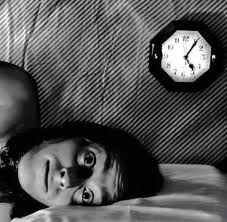“To sleep, perchance to dream-
ay, there’s the rub”
— William Shakespeare
There is insomnia, and then there is “Mother’s Insomnia”. You might know the kind: it starts as soon as you have a baby. I half think I put off having a baby until I was 40 because I knew I would have my beautiful childless nights of sleep and sex snatched away from me forever. Oh, I could see it coming. I had heard the stories from my friends. Kristina had a particularly difficult time with her son and his sleep schedules until he was about 5 years old. She and her husband used to take turns checking alone into a nearby motel every few months or so just to get caught up on their sleep. My friends Jen and Chris looked like prisoners of war after at the end of the first year of baby Lilly’s life.
Tips For Battling Insomnia
These were my horror stories – worse than ax murderers or serial rapists on the loose – that would leave me shaken and reeling. For I was a sleeper – I loved my sleep and I could literally sleep the sleep of the dead for 8, 9, 10 hours at a stretch without a problem. Insomnia was as foreign a concept to me as flying coach is to Madonna. But have a baby I eventually did. Without fail, I was swirled into the maelstrom of night nursing and middle of the night wakefulness sure that a maniac child snatcher was lurking just outside my doors. I began existing on 2 hour stretches of sleep at a time, my hypervigilence like a mother bear in full swing. I don’t think I got a good solid uninterrupted 8 hours for three or four years there. Once she hit school age, and the scheduling as if running an Olympics began, it was the thing that would jerk my head up off the pillow at 3 am: did her ballet tights get washed? Did the field trip permission slip get sent in? Crap, I forgot to pick up baby carrots for her lunch. (Quelle horreur that she should have to eat a regular peeled and cut up carrot.) My husband, of course, was immune to all of this – a burglar would have to literally hit him with a baseball bat on top of the head to alert him to his presence.
My sleep issues, it seemed, granted me automatic membership in a particular club of women.
The New York Times describes that an astonishing 80% of women report insomnia at some time. In a National Sleep Foundation, 2007 “Women and Sleep” study, the use of prescription sleep aids among women peaks from ages 40 – 59 – the intense years we are raising our families, working to our top potential in our careers, and generally, burning the midnight oil in the quest to stay on top of the business of our over scheduled and stressed out lives. In 2011, 15 and a half million American women got a scrip for helping them sleep, nearly twice the men in that age group.
The myriad of health issues that get triggered by chronic insomnia are many and serious:
• Sleep is necessary to rejuvenate the connections between brain cells essential for memory, executive functioning (necessary for goal-directed behavior), and attention.
• Growth hormones necessary for building and maintaining healthy muscle tissue are produced during sleep. Over time, insomnia can deplete muscle strength.
• Sleep deprivation lessens white blood cell activity, which increases risk for getting sick. As well, a healthy immune system promotes deep sleep, so long bouts of insomnia can set up a vicious cycle.
• Insomnia interferes with body’s ability to metabolize glucose, leading to early signs of diabetes. Getting less than 6 hours of sleep a night makes you 4 ½ times likely to develop pre-diabetes.
• People with chronic insomnia are five times more likely to suffer depression and 20 times more likely to suffer panic disorders.
• Recent studies indicate that even in healthy 20 year olds, cutting sleep to four hours from 8, four nights in a row, triggered hormonal changes that caused weight gain. Yep, not only does insomnia make you dog tired, it also makes you fat. Just hearing that is enough to cause depression and panic.
• Growth hormones necessary for building and maintaining healthy muscle tissue are produced during sleep. Over time, insomnia can deplete muscle strength.
• Sleep deprivation lessens white blood cell activity, which increases risk for getting sick. As well, a healthy immune system promotes deep sleep, so long bouts of insomnia can set up a vicious cycle.
• Insomnia interferes with body’s ability to metabolize glucose, leading to early signs of diabetes. Getting less than 6 hours of sleep a night makes you 4 ½ times likely to develop pre-diabetes.
• People with chronic insomnia are five times more likely to suffer depression and 20 times more likely to suffer panic disorders.
• Recent studies indicate that even in healthy 20 year olds, cutting sleep to four hours from 8, four nights in a row, triggered hormonal changes that caused weight gain. Yep, not only does insomnia make you dog tired, it also makes you fat. Just hearing that is enough to cause depression and panic.
In all seriousness, there is no need to let these horrifying facts keep you up tonight. There are various ways to move yourself from a chronic insomniac to a successful sleeper by making just a few easy adjustments in your life.
SUCCESSFUL SLEEPING
Assess your bedroom
• Dim the lights, as insomnia feeds off the minor details of modern life, like the lights from a tv, computer, cell phone, and digital clock. Blue lights suppress the secretion of melatonin, the sleep promoting hormone. Read a book or do deep breathing instead of watching tv or computer or ipad before bed. Replace regular white bedside bulbs with an orange ones, which allows relaxation and reading but won’t inhibit melatonin.
• Update any mattress older than 5 years old. Replace mattress with organic one or cover with a mite-resistant casing instead. Dust mites feed on human skin and are a major trigger for asthma and allergies, which can cause sleeplessness.
• Keep bedroom 65 degrees or colder (the worse your insomnia, the colder it should be). Keeping cool slows down all of your body’s metabolic processes including the mental whirring of the brain.
• Update any mattress older than 5 years old. Replace mattress with organic one or cover with a mite-resistant casing instead. Dust mites feed on human skin and are a major trigger for asthma and allergies, which can cause sleeplessness.
• Keep bedroom 65 degrees or colder (the worse your insomnia, the colder it should be). Keeping cool slows down all of your body’s metabolic processes including the mental whirring of the brain.
Create a better bedtime routine
• Don’t go to bed hungry. An empty stomach makes it harder to fall asleep. Eat mild, easy to digest foods that are not greasy or spicy. A small bowl of brown rice or plain whole wheat pasta, a few slices of avocado rolled inside a corn tortilla or a small banana would do fine here.
• Skip using a shot of alcohol or glass of wine to fall asleep. After the initial tranquilizing effect wears off, up to 20% of people who use this method, report interrupted and fitful sleep as the alcohol wears off. Drink chamomile tea instead.
• Wear socks to keep the blood vessels in the feat dilated, which will draw blood away from your core and cool you off, which initiates sleep.
• Skip using a shot of alcohol or glass of wine to fall asleep. After the initial tranquilizing effect wears off, up to 20% of people who use this method, report interrupted and fitful sleep as the alcohol wears off. Drink chamomile tea instead.
• Wear socks to keep the blood vessels in the feat dilated, which will draw blood away from your core and cool you off, which initiates sleep.
Insomnia-proof your lifestyle
• Practice “sleep-restriction” – make your bed a welcome sight at the end of a long day instead of a place you dread and associate with insomnia. Instead of spending inordinate time in bed tossing and turning, only stay in the bed if you are actually sleeping. Try to get up at the same time every morning, even if it’s quite early and even on weekends. Once you’re falling asleep more easily at night, you can slowly push your wake-up time forward. (Useful tip: should you find yourself wide awake at 3 am, go ahead and get up and use the quiet time to clean out your cupboards, organize your address book, write the thank you notes you haven’t yet. Or meditate. In other words, get caught up, be productive. You don’t have anyone interrupting you at this time, for better or worse.)
• Time your workouts and exercise sessions for late afternoon or early evening (no later than 2 hours before bedtime, though). This will cause your body temperature to fall after it has been increased through the exercise. Falling body temp relaxes and causes a better climate for sleep.
• Break smartphone addiction – do not keep it in your bedroom and don’t get on it at least an hour before you plan to go to bed. Study after study shows it interferes with sleep, causes headaches and least restful slumber.
• Take magnesium supplements to get rid of restless leg syndrome and leg cramps, which are often partners to insomnia.
• Time your workouts and exercise sessions for late afternoon or early evening (no later than 2 hours before bedtime, though). This will cause your body temperature to fall after it has been increased through the exercise. Falling body temp relaxes and causes a better climate for sleep.
• Break smartphone addiction – do not keep it in your bedroom and don’t get on it at least an hour before you plan to go to bed. Study after study shows it interferes with sleep, causes headaches and least restful slumber.
• Take magnesium supplements to get rid of restless leg syndrome and leg cramps, which are often partners to insomnia.
My good friend Kim Colwell of the Shambhalla Institute, is a second generation Feng shui expert. Her tips for treating insomnia have to do with cultivating a physical environment that is conducive to sleep. Feng Shui principles are big on how your bedroom is set up for these exact reasons.
Feng Shui tips for battling insomnia and creating bedroom harmony:
• Get rid of clutter under bed (the detritus of your life will negatively affect you)
• See the door (your feet should not point directly at the door, however)
• No photos of family or friends (just you and your love)
• Make sure all artwork/bric a brac are in pairs to represent the two of you
• Make sure all furniture/lamps beside the bed match (balance for relationship)
• Soothing colors (this is obviously very subjective, but generally cool, calming colors -blues, greens, neutrals- are considered more soothing than “hot” colors – reds, oranges, yellows)
• Include nature aspects in your décor or layout (windows opening onto a view of a garden, seashells artfully arranged on a shelf, artwork that is nature based, natural fiber rugs, etc.)
• See the door (your feet should not point directly at the door, however)
• No photos of family or friends (just you and your love)
• Make sure all artwork/bric a brac are in pairs to represent the two of you
• Make sure all furniture/lamps beside the bed match (balance for relationship)
• Soothing colors (this is obviously very subjective, but generally cool, calming colors -blues, greens, neutrals- are considered more soothing than “hot” colors – reds, oranges, yellows)
• Include nature aspects in your décor or layout (windows opening onto a view of a garden, seashells artfully arranged on a shelf, artwork that is nature based, natural fiber rugs, etc.)
Finally, I will leave you with something to sleep on – my absolute favorite quote right now:
“I love sleep. My life has the tendency to fall apart when I’m awake, you know?”
— Ernest Hemingway
— Ernest Hemingway




Recent Comments